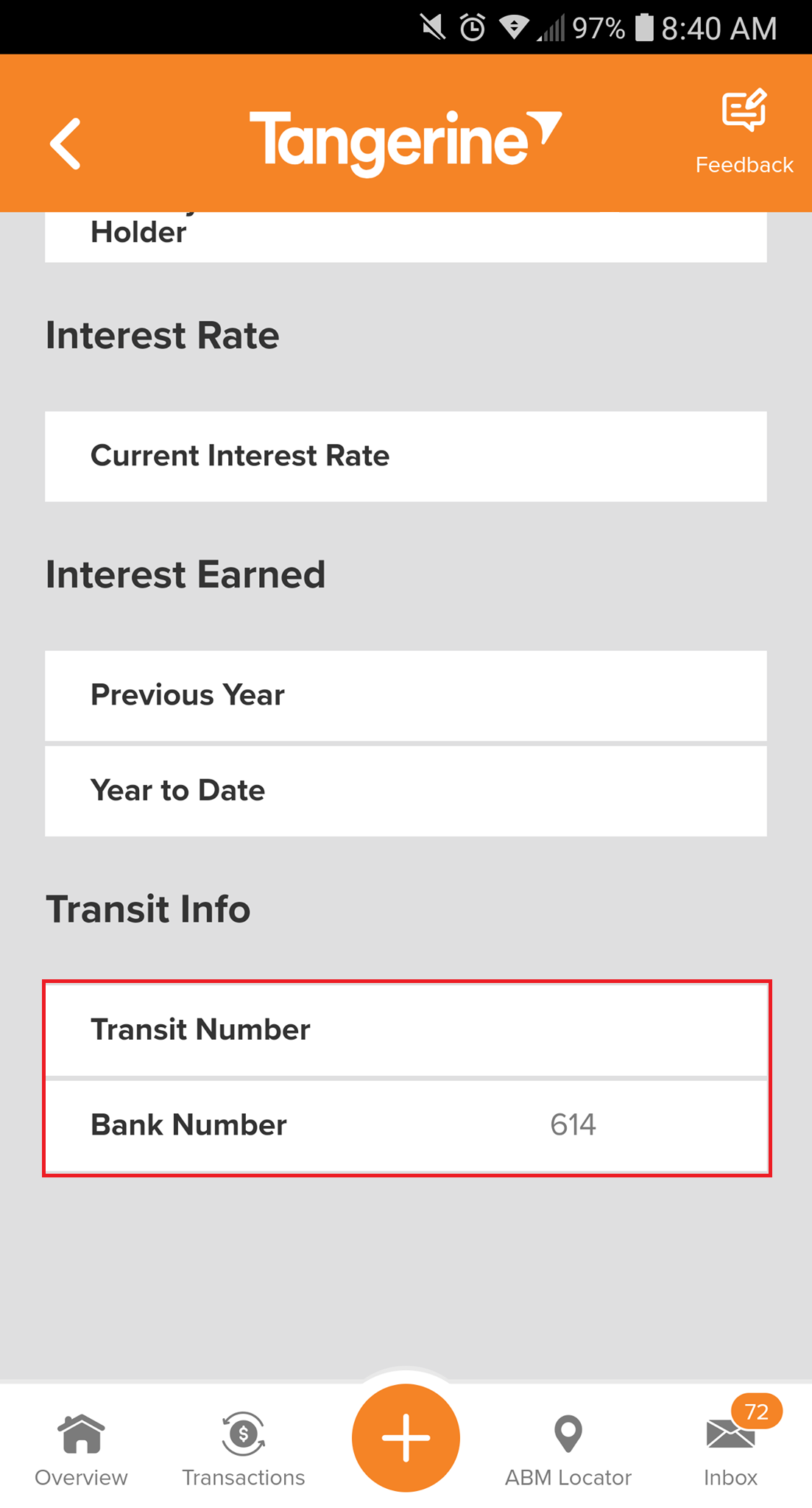Rule #1: Check your work. Rule #2: Double check your work! Rule #3: TRIPLE check your work!!! Rule #4: FOR THE LOVE OF ALL THAT IS GOOD IN THE WORLD, CHECK! YOUR! WORK!!!!!! Rule #5: Do NOT forget the ON-BEN application. This is often all the money that a client will walk away with considering the types of clients we have. Rule #6: Do NOT assume anything. This is a learning experience for you, and it is perfectly acceptable for you to ask questions, and it is expected. You won't be judged for it. You will be judged if you decide to make up facts and lie. Don't assume anything, just makes an ass out of you and me, but mostly you. Rule #7: I do NOT tolerate ANY harassment at our tax clinic at all. Especially towards our volunteers. If you are ever put into a compromising situation, or otherwise made uncomfortable, please notify me immediately. I have called security in the past when necessary, and I will not hesitate to do it again. I only ask that you treat clients and your fellow volunteers with the same respect. You can be an ass to me all you want, I got thick skin. Rule #8: Please use the control sheet, and flip it over immediately and fill out the information once you start the tax return. If anything has been checked off, make sure you ask about it. Rule #9: We receive a lot of international students here, so if they're an international student, ask what year they came to Canada. If the year of entry is the year the client entered Canada, please fill out the immigrant form. Rule #10: CHECK YOUR WORK!
Tax Clinic Common Questions
If you're reading this, you're looking for particular questions for the Tax Clinic. Please see below to see if any of the below categories answer your question.
What is the GST/HST Credit?
Official answer: The GST/HST credit is a credit that is paid to low/middle income families every quarter. It is supposed to represent amounts paid for GST/HST paid for basic living in Ontario.
Sassy Answer:You're receiving the credit because you're poor. Government of Ontario says let's make life easier for you and refund you the money you paid for basic living in Ontario.
What is the Ontario Trillium Benefit?
Official answer: The Ontario Trillium Benefit (OTB) a credit that is paid to low/middle income families every month. It represents 3 credits in one, the Ontario Energy and Property Tax credit,
the Northern Ontario Energy Credit, and the Ontario sales tax credit. Most people who pay either property tax or rent are eligible for the OTB. This credit is supposed to represent
amounts paid for GST/HST on energy.
Sassy Answer:You're receiving the credit because you are poor, and you paid for rent/property taxes. Goverment of Ontario says let's make life easier for you and give you some money back.
How do I apply for these credits?
You automatically qualify for these credits if you're a low income resident of Ontario, but there's no harm in applying anyways - the worst that will happen is that your tax software will say
you don't qualify.
In your tax software, go to the ON-BEN form, and select "Applying for the Ontario Energy and Property Tax credit". In Ufile it is the second box, in Simple tax it is the first. If you live in
Algoma, Cochrane, Kenora, Manitoulin, Nipissing, Parry Sound, Rainy River, Sudbury, Thunder Bay, or Timiskaming, you also qualify for the Northern Ontario Energy Credit.
You MUST fill out your rental information, including total property tax or rent paid, and declaration of your principal residence. Note that living on campus is DIFFERENT from renting,
as student housing is partially subsidized by the government, and a separate box should be selected.
I've done all of this but my software says I'm not getting anything!
There are three possible outcomes.
1) You did your tax return wrong. After triple checking your work, and ensuring all required items have been filled out, move on to 2.
2) You will not be turning 18 at the time of the payment. The payments will only be paid to those who have reached the age of majority at the time of payment.
3) You earned too much income, and you are no longer considered a low-income resident.
I'm being asked about the "Welcome to Canada" benefit, what is that?
You will hear many international students ask about a "Welcome to Canada" benefit - particularly international students from India where this was popularized.
Bottom line: The "Welcome to Canada" benefit does not exist.
An accountant from Halton Hills came up with a marketing ploy in order to generate more business from international students/newcomers to Canada. Unfortunately, he failed to advise his clients that they were actually filing tax returns.
Unfortunately for us (and I guess fortunately for him) this ploy was a grand success, and this phrasing of the "Welcome to Canada" Benefit perpetuated for years through word of mouth and online forums. We were confused for YEARS, not understanding what clients were asking for, as we had never heard of this benefit before, nor did any other accountant we asked.
FINALLY we found this article which explained everything. The "Welcome to Canada" Benefit is just the GST/HST Credit and Ontario Trillium Benefit. They get this automatically when they submit the RC151 and T1. There is no separate benefit.
Code 78 You already EFILED it, it's gone Jim.
Code 121 Go to Settings-> Efile-Netfile Setup, and doublecheck that your EFILE information is correct.
Code 130 Paper File it.
Code 131 Contact Ben Ma.
My client says they've deposited $10,000 in a GIC and they don't have a T5 for interest! I consulted with my people, and we did our research. The application fee for this program is about $100-$200 dollars. The interest is around ~$50 at most. You can exclude/ignore this amount, there's no T5 to supplement and the cost to earn this income is greater than the actual income. International students need to prove they have sufficient funds to support their education in Canada.
Can we claim moving expenses? If you moved at least 40km closer to your new workplace or for school, yes you can claim moving expenses. Generally not worth it to claim moving expenses for school since it can only be claimed against things like scholarship income, which is tax-free anyways.
What can you claim as medical expenses Any prescription drugs, dental, vision, surgeries, prescribed vacinnations, or insurance premiums can be claimed as medical expenses as long as they are paid out-of-pocket. YES. YOU CAN CLAIM UHIP, HEALTH INSURANCE PREMIUMS AND SUCH PAID THROUGH THE UNIVERSITY. This means that the taxpayer must have paid these amount and was not reimbursed by insurance. This list is not exhaustive and can include many other items. Students at Universities often pay costs like these through their student fees. You should carefully inspect your fees to see if any costs are marked as health premiums or UHIP.
Can we claim FedCare, UHIP, StudentCare, and other health insurance premium payments? Any prescription drugs, dental, vision, surgeries, prescribed vaccinations, or insurance premiums can be claimed as medical expenses as long as they are paid out-of-pocket. As stated above, YES.
Is it okay if they don't have rent receipts right now? Yes. As long as they know the EXACT amount that they paid for rent, this is fine. Please note that CRA regularly audits this information, and will likely request for it in the future. You can quote me as such. "We can file that you have rent receipts, you have to be aware that the CRA may audit you regarding your receipts. If you do not provide valid receipts by the time the CRA audits you, they will ask for a repayment of funds, plus interest. A valid receipt is a letter signed by your landlord or cancelled cheques. E-transfers, cash, and a contract are NOT valid receipts." At the time of the audit, the taxpayer MUST have proof of rent receipts available. This can be in the form of cancelled cheques or rent receipts signed by the landlord
What information must be included on a rent receipt? Landlord's name, tenant's name, months lived at address, address, and amount paid (total or monthly), and signature of landlord.
What are tuition credits, and how can I use them? Canada does not want you to be unduly punished for paying fees to go to post-secondary school. Canada then says "Okay, for every dollar paid for tuition, you do not need to pay 15 cents of taxes." If you paid $1,000 in tuition, you get a tax credit to reduce your taxes by $150. Ontario used to have a tuition credit, but this was phased out in 2017.
What if I'm not paying tax anyways? If you're not using all your tuition credits, you have two options available to you: 1) Carry forward the credits. Any unused credits can be carried forward indefinitely and applied against a year where you do have income. 2) Popular amongst parents, you can transfer up to $5,000 of tuition credits ($750 of tax savings) to a parent. This can only happen in the year you receive a T2202 (you can't transfer credits from a prior year)
Where do I find the carryover credits from prior years? These are listed the Notice of Assessment, or on Sch.11 and ONSch.11 (if there are provincial credits pre-2018) of the prior year tax return. Look the tax return from last year and search for S11 for that information. Alternatively, look at last year's Notice of Assessment.
Can we use payroll/ROE instead of a T4? No. Payroll stubs do not always show all amounts received by the employee, and some benefits may not be included. T4 is the official document that must be used whenever possible.
My client can't find their T4! Call the CVITP Helpdesk on Monday-Saturday, and they can provide that info. Ask me for this number.
I can't find box 014 on the T4A! It's a registrant number, ignore it.
When I put in information from box 20 and box 48, I'm getting an error! This is due to these boxes being considered self-employment income. Contact a mentor immediately.
I can't find Box 105 on the T4A! Go to box 28+, there's a dropdown menu there. We went over this in training. Tsk.tsk.
How do I find the info for direct deposit? You need 3 sets of numbers - the Branch No. (5 digits), the Institution No. (3 digits), and the Account No. (up to 12 digits). See below for instructions on particular banks.
Online Banking
1. Log into Online Banking
2. Go to My Accounts
3. Select your preferred deposit account
4. Your deposit information can be found as indicated in the image below.
 Mobile Banking
1. Log into Mobile Banking
2. Select your preferred deposit account
3. Select the "i" icon in the top right, and your direct deposit information will show.
Mobile Banking
1. Log into Mobile Banking
2. Select your preferred deposit account
3. Select the "i" icon in the top right, and your direct deposit information will show.

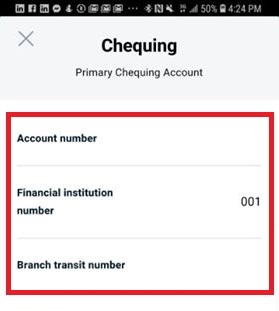
Online Banking
1. Log into Online Banking
2. Go to Products and Services
3. Select either "Void Cheque" or "Direct Deposit/Payroll Form" as indictated in the picture below.
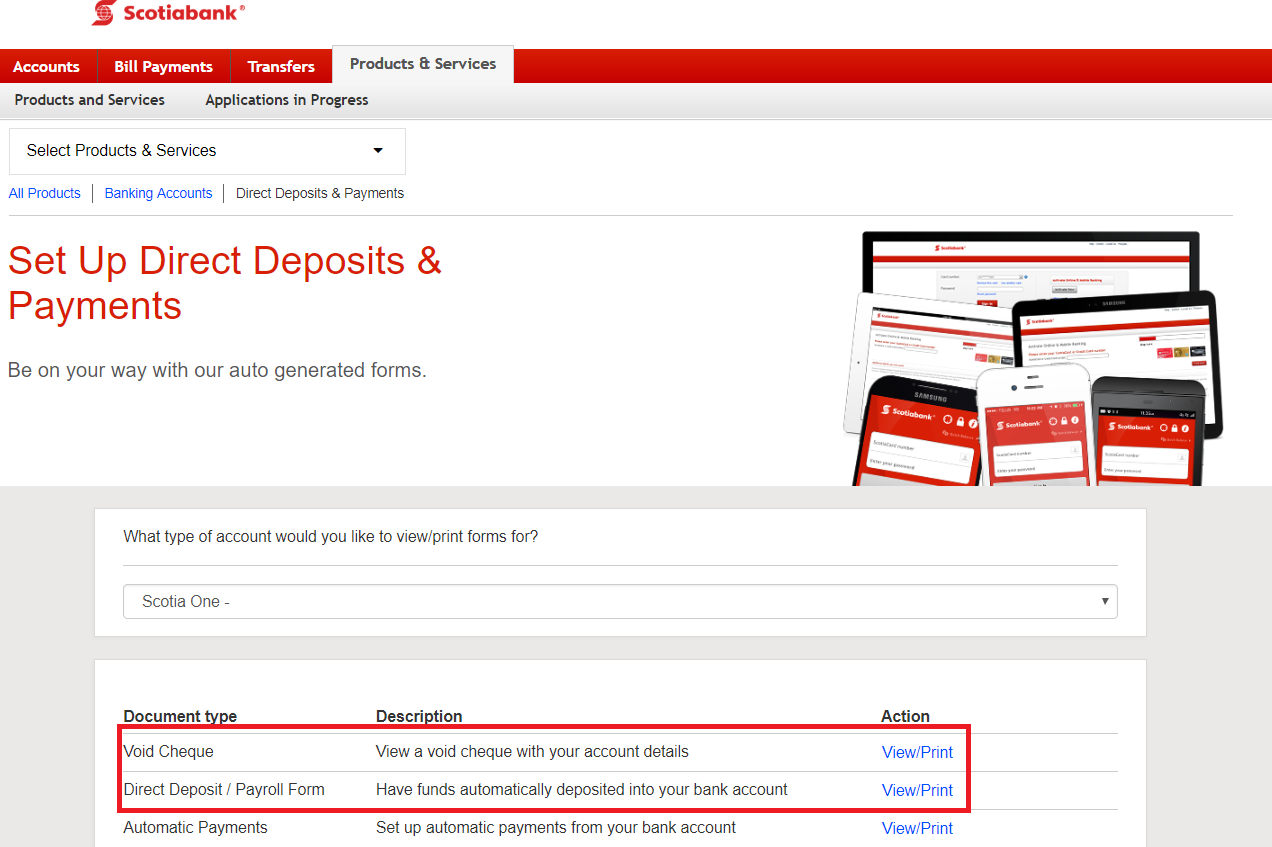 Mobile Banking
1. Log into Mobile Banking
2. Select the bank account that you would like your money to be deposited to.
3. Select "Direct Deposit Details"
Mobile Banking
1. Log into Mobile Banking
2. Select the bank account that you would like your money to be deposited to.
3. Select "Direct Deposit Details"

Online Banking
1. Log into Online Banking
2. Go to My Accounts
3. Go to Profile & Account Settings
4. Under Account Services, select either "View Payroll direct deposit form" or "View void cheque" as indicated in picture below.
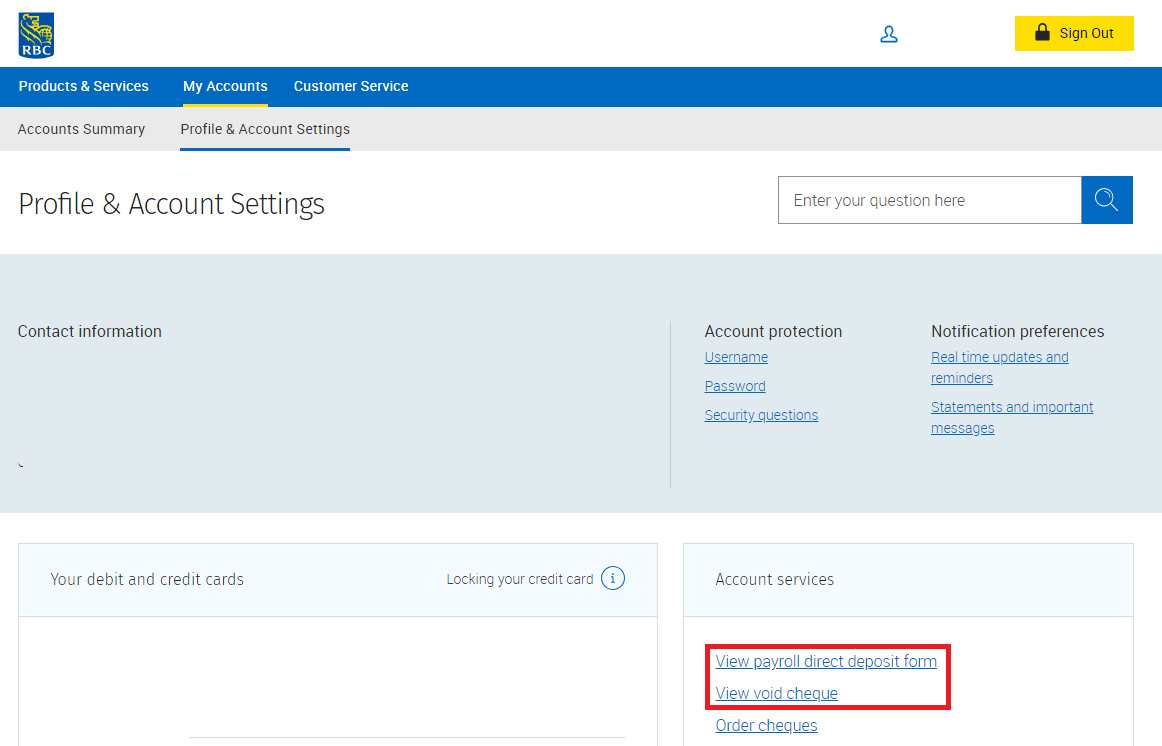 Mobile Banking
1. Log into Mobile Banking
2. Select the bank account you'd like to deposit to.
3. Select details
Mobile Banking
1. Log into Mobile Banking
2. Select the bank account you'd like to deposit to.
3. Select details
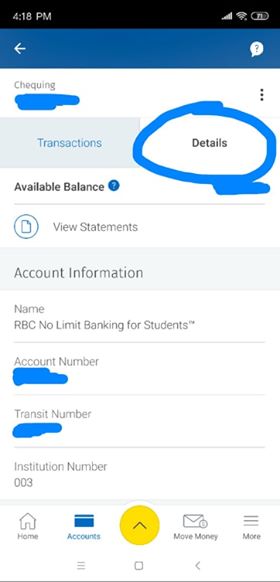
Online Banking
1. Log into Online Banking
2. Select the bank account where you would like your money to be deposited.
3. Click the "Direct Deposit Form (PDF)" seen in the picture below.
4. See the PDF form for the Direct Deposit Numbers.
 Mobile Banking
Direct deposit information is not available on mobile for TD.
Mobile Banking
Direct deposit information is not available on mobile for TD.
Online Banking
1. Log into Online Banking
2. Select the bank account where you would like your money to be deposited.
3. Find the Direct Deposit Information in the image below.
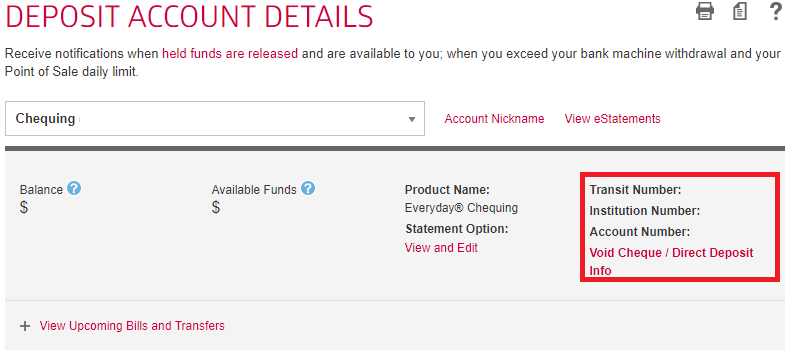 Mobile Banking
1. Log into Mobile Banking
2. Select the bank account where you would like your money to be deposited.
3. Go to Account Info and find the direct deposit information.
Mobile Banking
1. Log into Mobile Banking
2. Select the bank account where you would like your money to be deposited.
3. Go to Account Info and find the direct deposit information.

Online Banking
1. Log into Online Banking
2. Select the bank account where you would like your money to be deposited.
3. Find the Direct Deposit Information in the image below.
 Mobile Banking
1. Log into Mobile Banking
2. Select the bank account where you would like your money to be deposited.
3. Go to Account Info and find the direct deposit information.
Mobile Banking
1. Log into Mobile Banking
2. Select the bank account where you would like your money to be deposited.
3. Go to Account Info and find the direct deposit information.
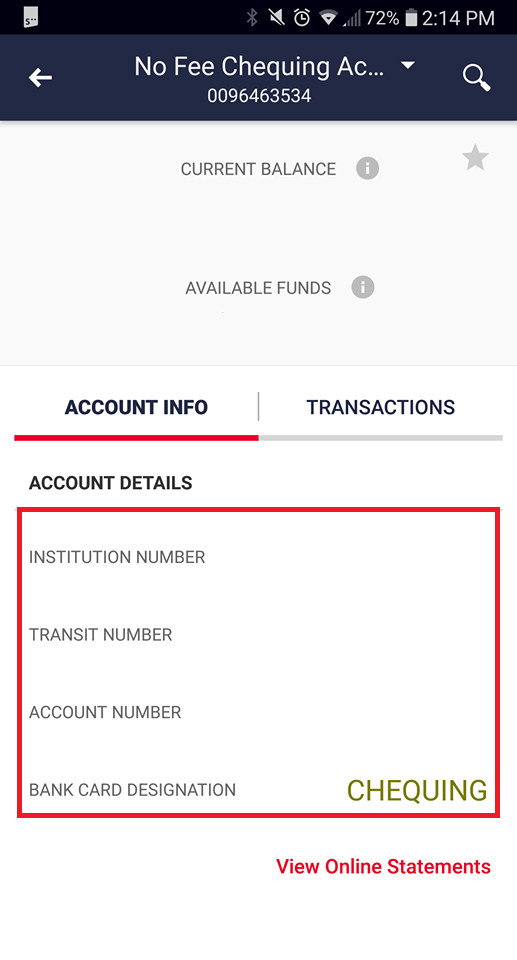
Online Banking
1. Log into Online Banking
2. Select the bank account where you would like your money to be deposited.
3. Click the "Void Cheque" button seen in the picture below.
4. See the PDF form for the Direct Deposit Numbers.
 Mobile Banking
1. Log into Mobile Banking
2. Select the bank account where you would like your money to be deposited.
3. Select Account details and scroll to find the direct deposit information. Alternatively, select "More Actions" and select Void Cheque to download a PDF.
Mobile Banking
1. Log into Mobile Banking
2. Select the bank account where you would like your money to be deposited.
3. Select Account details and scroll to find the direct deposit information. Alternatively, select "More Actions" and select Void Cheque to download a PDF.

